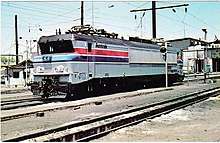SNCF Class CC 6500
The SNCF Class CC 6500 is a class of 1.5 kV DC electric locomotives. The CC 6500 was, together with the CC 40100 and diesel CC 72000, the first generation of the 'Nez Cassé' family of locomotives and designed for hauling express trains with speeds up to 200 km/h (124 mph) but also used for heavy freight trains. Among the trains they hauled in their first years of service were the SNCF flagship train Le Mistral and Trans Europ Express trains Aquitaine, Le Capitole and l'Étendard.[1]
| SNCF Class CC 6500 | |||||||||||||||||||||
|---|---|---|---|---|---|---|---|---|---|---|---|---|---|---|---|---|---|---|---|---|---|
CC-6572 at Cité du Train de Mulhouse, Mulhouse, France | |||||||||||||||||||||
| |||||||||||||||||||||
| |||||||||||||||||||||
| |||||||||||||||||||||
| |||||||||||||||||||||
Technical details
The locomotives had 3-axle monomotor bogies with each set of 3 axles coupled by gears. Speed regulation was by rheostats and series-parallel control. The motors had double armatures so there were four "demi-motors" which allowed three motor groupings: full series, series-parallel and full parallel. The power controller had 28 steps.
Production
Between 1969 and 1976 a total of 74 were built, with the last of this class taken out of service in 2007. Four more were built as dual-system 1.5 kV DC/25 kV AC locomotives, series CC21000. In 1997, these were reconfigured for use as DC only locomotives, taking the total of CC6500 locomotives to 78.
Amtrak

In 1977, Amtrak borrowed SNCF CC21003 for testing purposes. This engine was rebuilt by Alsthom with its transformer and electrical components replaced with those compatible with Amtrak's 25 Hz traction power system, taller pantographs, Amtrak's cab signaling system, US style couplers, a bell, and other components required by the AAR for operation on US railroads. This engine, and a Swedish SJ Rc4 were imported and tested by Amtrak to determine the best design to replace the aging PRR GG1's operating on their Northeast Corridor. However, the X996's suspension system proved unsuitable for the relatively rough US track construction, and despite modifications made over the course of testing, the engine's performance was deemed unsatisfactory for Amtrak's use. Thus, Amtrak favored the Rc4 design, which would serve as the basis for their EMD AEM-7. After testing was completed, X996 was returned to France, reverted to its pre-Amtrak appearance and specifications, and continued to operate on the SNCF. As with the remainder of the CC21000's, the CC21003 was rebuilt into a CC6500 in 1997.[2]
References
- Nock, O.S. (1978). "The Aquitaine: pioneer of electric power", in World Atlas of Railways, pp. 120–121. New York: Mayflower Books (original publisher: Artists House, London, UK). ISBN 0-8317-9500-X.
- "Amtrak's X996". www.amtrakhistoricalsociety.org.
Further reading
- Perren, Brian (April 1983). "Riding a French legend". Rail Enthusiast. EMAP National Publications. pp. 22–27. ISSN 0262-561X. OCLC 49957965.
| Wikimedia Commons has media related to SNCF Class CC 6500. |